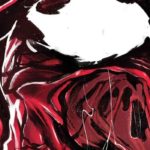
This past summer, everyone’s favorite Canuck starred in Wolverine: Black, White, and Blood. The series has been an overall success for Marvel Comics, and, because of that, Marvel decided that the Wolverine series should not be the last time the concept of a limited series with a minimal color scheme was used. This time, however, instead of using one of their most popular heroes, the homicidal Carnage is the star.
been an overall success for Marvel Comics, and, because of that, Marvel decided that the Wolverine series should not be the last time the concept of a limited series with a minimal color scheme was used. This time, however, instead of using one of their most popular heroes, the homicidal Carnage is the star.
Carnage: Black, White, and Blood #1 features the title character in three distinct short stories.
In Love Story, Carnage is battling some of Earth’s mightiest heroes while also trying to reunite with the love of his life. As Carnage fights against some of the heroes, he tells the story of a man from years ago that serves as the inspiration for some of his more homicidal thoughts. The past and present action is presented at break-neck speed. On many of the pages, the panels are stacked right on top of each other, often with no gutters between them. While this style works in some places, at other times, it makes the switch between periods jarring. One thing that has become obvious over the last few years is that Tini Howard knows how to write “supes,” and she once again proves that here. The quips and dialogue between Carnage and Cloak help to move the story forward. However, just like the art, the dialogue is jumbled up at points and leads to confusion.
In the second story, End of the Trail, we find Carnage out west. An unnamed old lawman is following the trail of some of the most heinous murders that he has seen. In the end, it seems as if the hunter in the story may have been the one being hunted the entire time. With the story being told from just one perspective of the lawman, it relies on the visuals of murder scenes to engage the reader. It is the story that makes the best use of the concept of limiting the palate to black, white, and red. The contrast of the red blood against the white snow jumps off the page while the blood bleeds into the foreground. While not a major issue, I would be remiss if I did not mention one flub in the writing. Near the end, Carnage makes the statement, “The west was won after all …Are written in blood.” I spent way too long looking for a missing panel and then trying to figure out if it was me who was misreading the statement. In the end, I decided it must just have been an error, but not before having to think about it for a while.
For those of us who enjoy tabletop adventure games, the final story, You Are Carnage, may seem familiar. Al Ewing uses the concept to allow the reader to decide their fate. In the story, the reader has been chosen to be part of a special government division in which you are attached to the symbiote. The reader’s task is to try to control the symbiote while fighting crime. If you are successful, you will become the latest American hero; if you fail, then you may lose your mind and maybe even your life. Ewing does a brilliant job of creating paths that are different yet plausible. This is the most fun of the stories to read, partially because of the ability to go back and try for a different outcome. McCrea’s choice to move away from the traditional look of Carnage and embrace a more “generic” avatar-type figure fits as it allows the reader to imagine themselves being taken over by the symbiote rather than just following along with another Cletus adventure.
While the stories are all vastly different, each writer is able to convey the characteristics that make Carnage a unique character. The off-kilter and chaotic energy jumps off of the panels, and any fan of Carnage should be able to find at least one favorite here. Having a limited set of colors to work with may present a challenge for some artists; however, without fail, each colorist uses a variety of shades to create visuals that match, and in some cases exceed, the fantastic writing.




